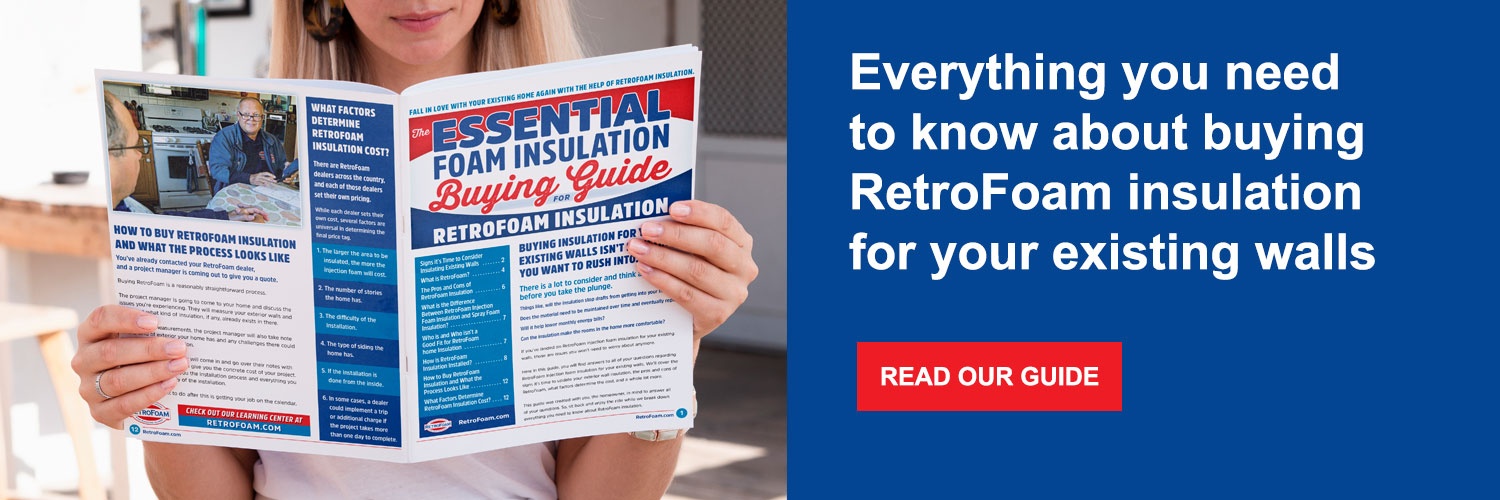Should I Insulate My Common Wall Between the House and Garage?


Should I Insulate My Garage Common Wall? (Quick Answer)
Yes, you should because this can be a source for air to move into and out of your home. Any airflow into the garage will come right through that common garage wall into your home. In the same sense, any air you’re paying to heat or cool can escape out into your garage.
Now, let’s discuss why insulating that common garage wall is a good idea.
You’re ready to update your exterior wall insulation with RetroFoam, but there is one spot you’re not sure about – the common wall between your house and garage.
To insulate that wall or to not insulate that wall is the real question here.
You may think you’re already covered since the garage will block the airflow from getting into your house, but that’s not how it works at all.
RetroFoam dealers across the country have been helping homeowners make their homes more comfortable and energy-efficient using RetroFoam insulation. With all of our experience, we’ll explain in this article why some homeowners may not want to insulate that common wall between the house and garage, why you should, and what the overall benefits are.
Now, let’s get started.
Why a Homeowner Wouldn't Want to Insulate the Garage Common Wall
Before we jump into why you might want to insulate that common garage wall, let’s talk about why someone might choose not to do it.
There are a few reasons why a homeowner may only want to insulate three of their four exterior walls leaving that common wall off of the scope of work.
Cost is one of those reasons. It’s really simple – insulating three walls instead of four will be cheaper.
Installing the RetroFoam injection foam insulation from the inside is another reason. To insulate the garage’s common wall, the installer will need to drill holes in the drywall into each cavity, which gives some homeowners pause.
Even though the installer will clean up any mess and do a rough patch on the drywall, the homeowner, in most cases, will need to do the final finish and paint the wall if they want. This extra work and expense are sometimes a turn-off to some homeowners.
Finally, some homeowners just don’t see the common wall as essential to insulate. They don’t look at this shared wall between the house and the garage as an exterior wall since the other garage walls somewhat protect it.
When it comes down to it, some homeowners don’t include the common garage wall in the scope of work because they just don’t see the value in insulating it.
Why Insulating the Internal Garage Wall is Important
You might not realize that keeping the common wall off of your scope of work could negatively impact the rest of your insulation project.
If the wall between the house and garage isn’t insulated correctly, air will be able to leak out of your home, as well as make its way in. You’ll experience drafts coming from that common wall, which was likely why you wanted to insulate your exterior walls, to begin with.
Do you leave your garage door open?
If you don’t insulate the shared wall, you’re inviting those drafts into your home, and you’ll still be dealing with uncomfortable rooms.
You don’t want to seal up your other exterior walls just to let air movement still happen through the common wall. RetroFoam creates an air seal that will keep outdoor air, allergens, and even sound from coming in through the garage.
Benefits of Insulating the Shared Garage Wall
The main benefits you’ll experience by updating your exterior wall insulation are more comfortable rooms and lower energy bills. Still, there are a few more you might not have known about.
Insulating that shared garage wall can help beyond making your home more comfortable and energy-efficient.
Reduce the Noise Coming from the Garage
If you use your garage as a place to work on projects, it probably gets a little noisy in there.
One of the benefits of RetroFoam insulation is that it works to make your home a little quieter. It won’t completely soundproof your home, but it will definitely help reduce the noise coming from your garage.
Keep Emissions from the Garage Out
You’re not running your car in the garage with the door down, but there are still a lot of emissions that live in that space.
RetroFoam will help keep out emissions, allergens, and even smells that traditional insulation like fiberglass will allow to pass through it. Fiberglass will even let those particles linger as it retains them as they pass through.
Creating an air seal in that common garage wall will help to make your home healthier.
Ends Moisture Concerns
If your garage isn’t a conditioned space with insulation, it’s likely way hotter or colder than the inside of your home.
This temperature difference can lead to moisture forming in the common wall, especially if there is fiberglass. This happens when the hot and cold meet, just like when you pull a pop can out of a cooler on a hot summer day – condensation forms on the outside of the can because of the temperature difference.
RetroFoam prevents those two temperature differences from meeting, thus preventing the formation of condensation.
Make Your Home More Energy Efficient with RetroFoam
RetroFoam has many benefits to offer to help make your home more energy-efficient and comfortable.
The key is sealing up all of your walls, so you aren’t leaving a space open for air to leak into and out of your home.
If you’d like to learn more about RetroFoam, check out the Learning Center on our website to find videos, articles, and resources to answer all your questions. If you’re looking for a RetroFoam dealer in your area, check out our Dealer Finder.
Related Articles
How Much Can RetroFoam Insulation Help Me Save on Energy Bills?
Does RetroFoam Insulation Work for Sound Dampening?
How Do RetroFoam Installers Know the Cavity is Full When Insulating Existing Walls?
About Amanda Emery
Amanda previously has worked as a breaking news and crime reporter, TV news producer, and editor. As a journalist, she has won several awards from The Society of Professional Journalists - Detroit Chapter and the Michigan Press Association. Amanda uses her experience as a journalist to write content that will help educate homeowners on foam insulation benefits. When Amanda isn’t writing, she’s spending time with her husband Chris, daughter Lilith-Maeve, and rescued huskies Danger and Wendigo. She also loves knitting, making art, and cooking.


